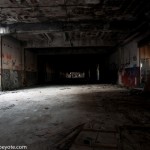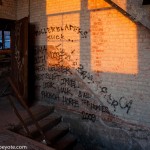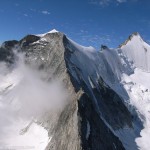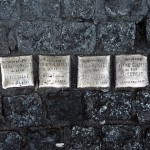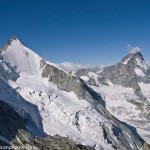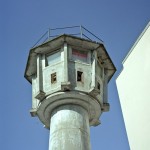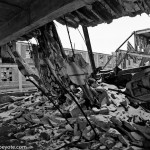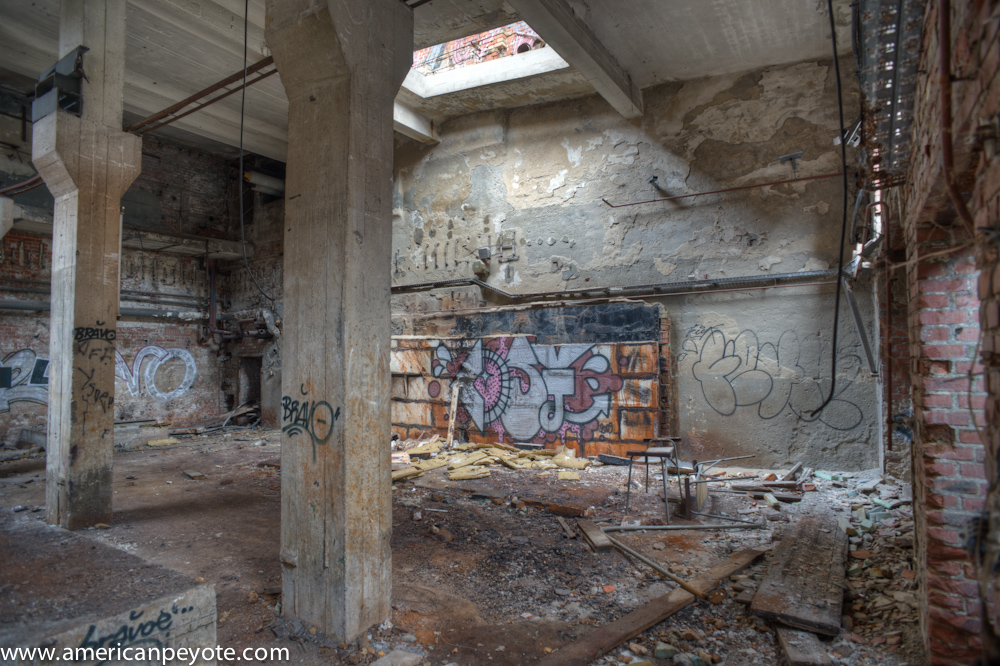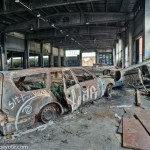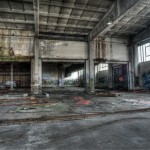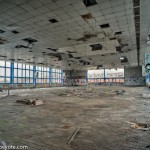 I don’t see ruins in Detroit, I see mountains and inspiration. The term ruins implies that something has not simply fallen into neglect, but is somehow lost to society. It is degraded beyond its intended state to such a degree that it is lost from redemption. The inspiration, the reason for creation has been lost and totally forgotten by those who built it, and no one wants to carry on the idea. We don’t remark on the ruins of Notre Dame or the ruins of DDR Berlin, and we don’t talk about the ruined glaciers and mountain ranges in Colorado. Ruin is a physical and mental state of being. A building can be old, the walls crumbling and the facade faded, and we can call Versailles a monument to the pinnacle of French art in the time of Louis XIV. I think of the chateau west of Paris as ruined as any other tourist building in Europe, where the inspiration for its creation has long since been neglected and ignored. The buildings exist to what was, but speak nothing of the future. What good is a beautiful building if it doesn’t inspire? Keeping the outside looking nice is irrelevant when the purpose for being no longer exists. Nothing useless is truly beautiful. Everything is in flux, and it’s all falling apart in one way or another. The Duomo cathedral in Milan is in ruins from my perspective, and as it’s rebuilt and reconstructed it contains physical pieces of yesterday and today, but the idea of Rome is as dead now as it was when the Empire failed and fell because no one cared to keep it going.
I don’t see ruins in Detroit, I see mountains and inspiration. The term ruins implies that something has not simply fallen into neglect, but is somehow lost to society. It is degraded beyond its intended state to such a degree that it is lost from redemption. The inspiration, the reason for creation has been lost and totally forgotten by those who built it, and no one wants to carry on the idea. We don’t remark on the ruins of Notre Dame or the ruins of DDR Berlin, and we don’t talk about the ruined glaciers and mountain ranges in Colorado. Ruin is a physical and mental state of being. A building can be old, the walls crumbling and the facade faded, and we can call Versailles a monument to the pinnacle of French art in the time of Louis XIV. I think of the chateau west of Paris as ruined as any other tourist building in Europe, where the inspiration for its creation has long since been neglected and ignored. The buildings exist to what was, but speak nothing of the future. What good is a beautiful building if it doesn’t inspire? Keeping the outside looking nice is irrelevant when the purpose for being no longer exists. Nothing useless is truly beautiful. Everything is in flux, and it’s all falling apart in one way or another. The Duomo cathedral in Milan is in ruins from my perspective, and as it’s rebuilt and reconstructed it contains physical pieces of yesterday and today, but the idea of Rome is as dead now as it was when the Empire failed and fell because no one cared to keep it going.
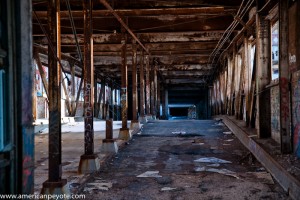 Remnants and Ruins
Remnants and Ruins
I think of the remnants of the empires of Detroit as the mountains of Michigan, physically and philosophically, and should all be turned into parks for everyone to experience and to explore. Exploration of the natural world feeds the adventure centers of the brain. The unpredictable landscapes and oceans challenge us to survive outside of our comfort zones and the trappings of society. I’ve always found adventure difficult to have in a city environment, and it’s a primary reason why I live in Switzerland, where a healthy balance between cities and outdoor exploration is embedded into society. I like places that inspire me to do things today.
Standing at the gates of Versailles makes me wonder what it was like when an angry mob knocked on the door for the head of Marie Antoinette (or was that only a movie). Standing in the main entrance of the Packard plant in Detroit makes me wonder what I could do in life if I applied myself a little bit more. I don’t see ruins in Detroit, I see mountains to explore and to be inspired by, and the main and most accessible mountain range is the Packard automotive plant. Packard is the Swiss Alps of Michigan, the Urbex Matterhorn of the Motor City. The feeling I have walking up crumbling stairs in Packard is the same sensation I experience descending down the ridge of the Zinalrothorn in Zermatt. The terrain is unsteady, you don’t know what’s around the next corner, and your sense of adventure is highly tuned to your surroundings.
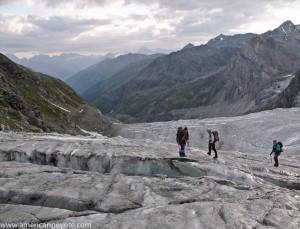 Glaciers of Detroit
Glaciers of Detroit
Packard is not a collection of ruins to me because I don’t feel like the inspiration which created Detroit is dead, but rather sleeping a little bit. Packard is a great collection of caverns to explore. Staring down the long dark halls is as mystifying as staring out across the width of the Aletsch Glacier in Switzerland. Cracks in the floor exposing the lower levels is like looking down into the long darkness of a large crevasse. The fallen ceilings and walls remind me of the car-sized boulders that litter the Oberaletsch Glacier. The plant is filled with the history of the city and the Empire era of Detroit. Like the glaciers telling the story of the ice leaving the landscape of Switzerland, Packard is covered with grafitti on the inside, telling different stories as time ticks by. The collapsed floors make me think of how the ice has carved images into the rock faces as it flows and then recedes.
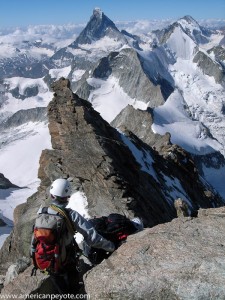 Both are living in a sense, the transformation is due to weathering and to humans. Water flows into cracks in rock and concrete, expands upon freezing, and another little piece breaks off the walls and mountain peaks. Both are dangerous and deadly to the naive who venture there, and a helmet, boots, and rope would be advisable in both the mountains of Detroit and Switzerland. Walking through Packard in my Doc Martens, I feel I look like the Japanese and Korean tourists who head up to the Junfraujoch in tennis shoes and a light jacket. We’re all looking for the same thing I think, life isn’t as complicated as writers like to think it is. Exploration is an important part of life, and both urbex and mountaineering combine physical tenacity with mental stamina.
Both are living in a sense, the transformation is due to weathering and to humans. Water flows into cracks in rock and concrete, expands upon freezing, and another little piece breaks off the walls and mountain peaks. Both are dangerous and deadly to the naive who venture there, and a helmet, boots, and rope would be advisable in both the mountains of Detroit and Switzerland. Walking through Packard in my Doc Martens, I feel I look like the Japanese and Korean tourists who head up to the Junfraujoch in tennis shoes and a light jacket. We’re all looking for the same thing I think, life isn’t as complicated as writers like to think it is. Exploration is an important part of life, and both urbex and mountaineering combine physical tenacity with mental stamina.
Packard is explored, Packard burns, it’s been gutted and probably there are sill bodies hidden away in dark corners, but it’s not a scary place to me. I stand there in awe. I’m awed by how it crumbles, how nature is taking it back to the earth. Empires can fall as quickly (or faster) than they were built, and this is an important perspective to understand. Europe houses the ruins of Monarchs, Fascism and Communism to name a few. Detroit saw the birth of industrial empires, but the inspiration for a second coming of Detroit is all around. Humans build up large things and think the monuments should exist forever, but they’re all being knocked down by time and the desire of people to maintain the momentum of an empire. This is perspective, this is the life and transformation of an Empire and everyone should see it. Empires are built and they fall. Huge masses of concrete can be built up and a few years go by and they are skeletons, just like you’ll be one day.
Packard looks like a city in the aftermath of a war, sitting on the far edge of the blast radius from a nuclear impact. Standing at that point where everyone gets vaporized and all the windows are blown out, but the buildings remains standing. I used to play paintball in Packard at a place called Splatball City, and if you look you’ll find remnants of those wars and happy times of my teenage years. People say it’s the fallout of economic war. They say that the result is the same as a military confrontation. Windows blasted out, nothing inside the walls anymore to support life – just places to hide away in from the wild life outside.
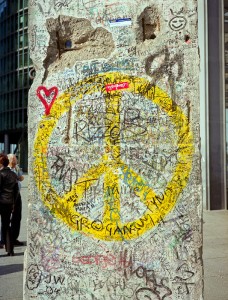 Detroit and Berlin
Detroit and Berlin
Packard 2010 probably looks a bit like Berlin in May of 1945. You can imagine snipers hiding away on the roof tops of Packard and werewolves plotting in the shadows as Russian soldiers drag German women into empty rooms. Or you can imagine Bratz dolls roaming the halls and chilling on window sills, but that’s just my imagination filling the page with bullshit for an unwritten movie script. A fitting notion, given the booming movie industry in current-day Detroit.
Like the glaciers, the ruins of Detroit won’t last forever, they are mortal, and must undergo the aging process like everything else in this world. The ruins of Detroit are fading like the ice in the Alps, or the melting snows of Killamanjaro. If you have the motivation and the opportunity, go check them out while you still can. Urban exploration is something you have to do in the moment. Old buildings get demolished or closed off, or their innards gutted as they transform from majestic theaters to forgotten memories. I take pictures of the glaciers because I want to show my grandchildren what it was like, in that time long ago when ice covered the Alps. It’s all in flux, and Detroit is getting reworked like Berlin in the late 90’s.
It’s not a bad thing that Potsdamer Platz now has a Sony Center instead of a no-man’s land, but’s good that you can still find one of the last guard towers if you know which street to walk down, and deportation memorials are all over the city if you care to notice them. Thousands of bodies and still forgotten in shallow graves on the WWII battle fields around the city. I feel like I barely know some parts of Berlin anymore because it has changed so much between 2003 and 2010, but that’s not a bad thing, that’s just life. I hope Packard will still be there in 10 years. However, if the skeleton is still there it might be a shopping mall, or a set of affluent apartment studios, but I hope that a few graffiti walls are left standing – like that lone section of the Berlin wall at Potsdamer Platz with a peace sign on it. I should live long enough to find out.
Eternal thanks to gatsbyj who I met via Flickr for taking me shooting in Packard.
